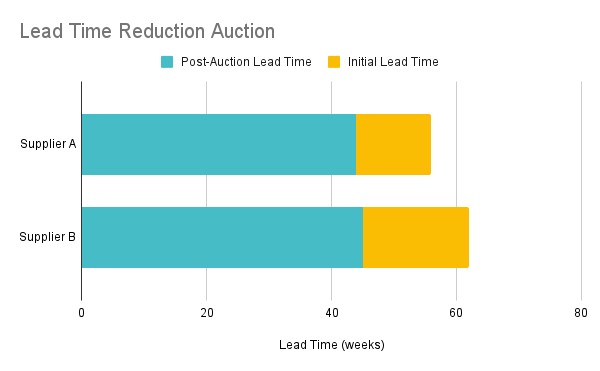As I was on a call with a supply chain leader last week, they brought up all the common objections to e-Auctions: Too impersonal. Too transactional. Don’t like them. So I asked what they were struggling with. “Lead times are still horrible on our key commodities” was one answer.
“Did you know you can auction lead times instead of just price?” I asked.
The look on their face said it all – they were already thinking about the applications. When I was at a large utility, we used to have projects where the large power transformer lead time was more important than its cost. Every week we saved was another week shorter for that project and another week of capacity to the grid. Our agreements with suppliers for pricing were reasonable and we had received good RFP responses that met spec, but we simply needed it faster.
So we ran an e-Auction for lead time in weeks after receipt of order. Our lead time dropped from about 13 months to 11.5 months, and pushed our suppliers to reconsider their manufacturing schedule.

Anything that can get to a bottom line number can be e-Auctioned, including lead time, scope 3 emissions, or a committed delivery amount based on a set budget. For lead time, a company can have suppliers bid their lead times down by weeks, business days, or calendar days. The buyer must be clear about the start and end of that lead time – is it from receipt of purchase order to delivery to the company’s dock? From contract signature to shipping from the supplier’s dock? Or even from completion of e-Auction to delivery to the third party logistics firm? Be clear about what lead time is being auctioned or it will all fall apart (as with all things e-Auction).
Scope 3 emissions are fairly new on the scene, with suppliers and companies still trying to define, calculate, and report them appropriately. If a company’s priority is on having suppliers reduce their scope 3 emissions, those commitments can be an e-Auction, even if the auction is for the target emission level by the end of the project/contract period. This uses the e-Auction to add clarity to supplier calculation requirements and define how they will be measured. A word of caution: if this is part of an e-Auction, the company should consider extra time for the suppliers to prepare their bids while the topic is still new in an industry. Consider also making this part of the RFP response ahead of an auction so the heavy lifting of calculating emissions was completed during that phase of the bid.
One last creative parameter is to run a forward e-Auction where the price or budget are set, but suppliers are bidding for how much they can accomplish for that price. In the utility industry, this might be the electric load reduction energy efficiency suppliers will commit to over the course of the contract. In another industry, it might be how many sales leads a supplier will provide or generate for a budget of $50,000. Or perhaps the number of customers the supplier will serve for that price. Any time the price is set but the deliverables are not, a forward auction can help a company’s resources reach greater impact.
An e-Auction is a powerful negotiation tool not limited to simple cost reductions on materials. It is a communication mechanism, clarity-adder, and transparency builder when the buyer focuses on the value they want to bring to their customer.




